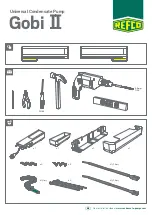
2
110529
A
B
C
D
E
F
G
H
WINDOW
NECK
“S” HOOK
FIG. 1
FIG. 2
WINDOW FILL-
IN PANELS
TOP PANEL
RETAINER
BOTTOM PANEL
RETAINER
COOLER INSTALLATION
MOUNTING COOLER
CAUTION:
Make sure that the mounting surface
is strong enough to support the operating weight of
the cooler when in use. (For operating weight, see
Specification Table.)
CAUTION:
Never plug in cooler until installation is
complete and unit has been tested for rigidity.
•
Lift out all removable louvered sides.
•
Screw chain hooks into window facing.
Position the two
chain hooks above the neck of the cooler a distance equal
to the width of the cooler apart (A-Fig. 1). Hook one hanger
chain in each hook and then an “S” hook in the other end of
each chain.
NOTE:
Chain hooks supplied with this mount-
ing kit have wood screw threads for wood walls. Concrete,
brick walls or concrete blocks require sufficiently strong wing
nuts or anchors with mating hooks.
RUBBER WASHER
OVERFLOW PIPE
NIPPLE
BOTTOM PAN
NUT
FIG. 3
•
Install window panel
retainers.
Place two
panel retainer strips
onto bottom of neck
flange and position to
the width of the win-
dow. Cut the strips to
fit if necessary. These
strips hold the window
fill-in panels (Fig. 2).
•
Position cooler in
window.
Position
neck of cooler so that
bottom of neck flange
rests on window sill
and flange (E-Fig. 1) is
snug against edge of
sill (H-Fig. 1). With
cooler in position, hook
the “S” hooks into the
holes of the top pan
near the back of the
cooler (B-Fig. 1).
•
Break fill-in panels to
fit.
With cooler in-
stalled, as described above, measure for each window fill-in
panel and score with sharp knife and straight edge guide to
desired width. To break window fill-in panels, the panel
should be laid over the edge of a straight flat surface at the
point to be broken off. Apply pressure on the edge of the
panel that extends over the edge of the surface and break
off unwanted piece.
•
Install fill-in panels.
Place one window fill-in panel on each
side of grill and into panel retainer strip at bottom of grill.
Place the other panel retainer strips onto top of neck flange
and fill-in panels. Be sure the panels are snug up against
cooler neck.
•
Place window behind retainer strip.
Raise back of cooler
so that the window (D-Fig. 1) may be brought down behind
top of panel retainer strip (C-Fig. 1).
•
Level Cooler.
Adjust chains so that cooler is level.
•
Adjust house legs.
Pull out house legs so that the rubber
bumpers rest against house siding (F-Fig. 1). Tighten screw
in retaining collar. (G-Fig. 1).
OPEN WINDOWS TO EXHAUST AIR
An often misunderstood concept of evaporative cooling is the
amount of air that should be exhausted. How much should
you open your windows? The fact is that most people do not
open their windows enough. The following method will help
you determine the amount to open your windows.
CHAMPION AIR BALANCING METHOD
1. Take a piece of tissue paper and cut it lengthwise into 3
equal strips.
2. Turn your cooler on high cool.
3. Open one window at least six inches wide in each room
that you want to cool.
4. Take the piece of tissue paper and put it up against the
screen of the open window furthest from the cooler dis-
charge opening. Let go of it. It will do one of three things.
IF
It falls down.
THEN
CLOSE all of the windows one inch and try step 4
again.
IF
It plasters itself to the screen.
THEN
OPEN all of the windows one inch and try step 4
again.
IF
It stays on the screen lightly.
THEN
PERFECT. You are done. Enjoy your cooler.
NOTES:
• When switching to low cool, you must rebalance your home.
Repeat step 4.
• Once you balance your home you can cool some areas
more than others by opening those windows more and clos-
ing the others by the same amount. Repeat step 4 to make
sure your home is still air balanced.
CONNECTING WATER
•
Install overflow assembly.
Re-
move nut and place nipple
through the hole in the pan, with
the rubber washer between the
pan and the head of the drain
nipple (Fig. 3). Screw on nut and
draw up tight against bottom of
pan. Insert overflow pipe in nipple
to retain water. The overflow pipe
may be removed to drain the pan when necessary. A gar-
den hose may be screwed onto the drain nipple to drain
water away from your unit.





























